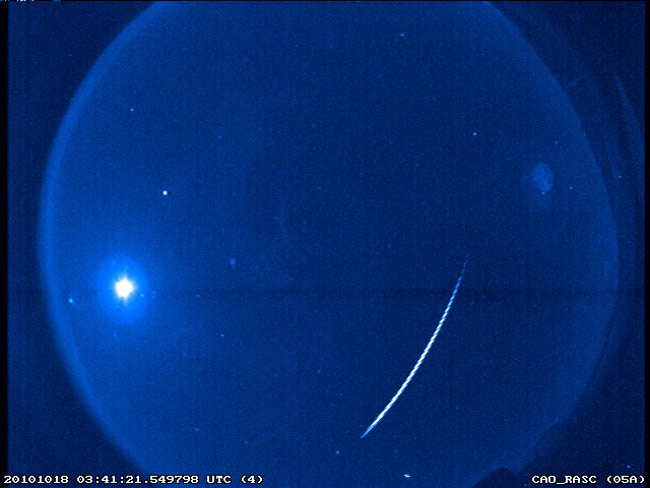Meteors From Halley's Comet Rain Down on Earth

This story was updated at 8 a.m. ET, Oct. 21.
Halley's Comet won't zoom near Earth againfor another 50 years, but the ice ball may still put on a show for someskywatchers this week in the form of a meteor shower.
Astronomers in Canada have snapped photos ofmeteors that are actually bits of Halley's Comet left behind during its long,looping, 76-year trip around the sun. [Photoof a meteor from Halley's Comet.]
Twice a year — in early May andmid-October — Earth plows through this cometary debris field and chunksof Halley's Comet burn up high in our planet's atmosphere, producing a meteorshower.
This year's October shower — called the Orionidmeteor shower,because it appears to come from the constellation Orion — has been goingon since Oct. 15, according to NASA officials. It will peak today (Oct. 21).
Watching Orionids is easy, but conditionsmust be right. Skywatchers should try to find a clear, dark sky far from peskycity lights.
Thisskywatching table showsprime Orionid meteor shower viewing times for some select U.S. cities.
Get the Space.com Newsletter
Breaking space news, the latest updates on rocket launches, skywatching events and more!
Here's how to spot the Orionids:
Go out after 11 p.m. local time, lie down andlook straight up. Once your eyes become dark-adapted, you'll start to seemeteors. Any of these that appear to come from Orion will be an Orionid, andtherefore represent a piece of Comet Halley doing a death dive into ouratmosphere.
In completely dark skies, skywatchers cannormally expect to see up to 30 Orionid meteors per hour, NASA officials saidin an update. Unfortunately, the light from the nearly full moon this week willwashout the fainter meteors, so the showerwon't be quite so dramatic.
Orionids move very fast, rocketing into theatmosphere at 147,300 mph (237,581 kph). At such an enormous speed, the meteorsdon't last long, burning up very high in the atmosphere.
Last year, the NASA allsky cameras atMarshall Space Flight Center in Huntsville, Ala., and in Chickamauga, Ga.,recorded 43 definite Orionid meteors, NASA officials said. Most of theseappeared at an altitude of 68 miles (110 kilometers) and completely burned upby the time they were 60 miles (97 km) above the ground.
Halley's Comet is about 7 miles (11 km)across, and the comet is visible from Earth every 75 or 76 years. It is namedafter 18th century astronomer Sir Edmond Halley, who predicted its return in1758.
The comet last returned to the inner solarsystem in 1986 and will come back in 2061 or so. Stargazers have noted itsregular appearances in the sky for thousands of years, including apparent cometsightings in ancient Greece that date back to 466 B.C.
The May meteor shower caused by Halley'sComet is known as the Eta Aquarids, as the meteors appear to come from theconstellation Aquarius.
- Images - The Best of Leonid Meteor Shower
- The Best Comet Images of All Time
- Moonlight Meteor Shower Spawned By Halley's Comet
Join our Space Forums to keep talking space on the latest missions, night sky and more! And if you have a news tip, correction or comment, let us know at: community@space.com.

Space.com is the premier source of space exploration, innovation and astronomy news, chronicling (and celebrating) humanity's ongoing expansion across the final frontier. Originally founded in 1999, Space.com is, and always has been, the passion of writers and editors who are space fans and also trained journalists. Our current news team consists of Editor-in-Chief Tariq Malik; Editor Hanneke Weitering, Senior Space Writer Mike Wall; Senior Writer Meghan Bartels; Senior Writer Chelsea Gohd, Senior Writer Tereza Pultarova and Staff Writer Alexander Cox, focusing on e-commerce. Senior Producer Steve Spaleta oversees our space videos, with Diana Whitcroft as our Social Media Editor.









